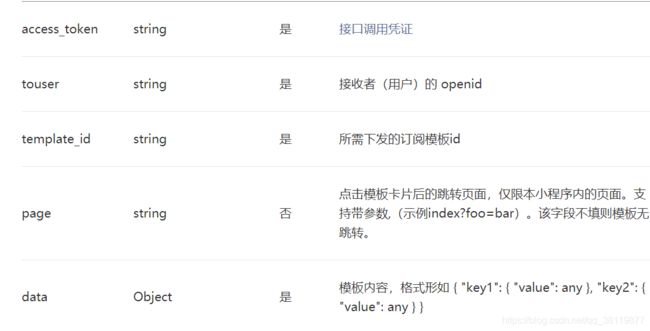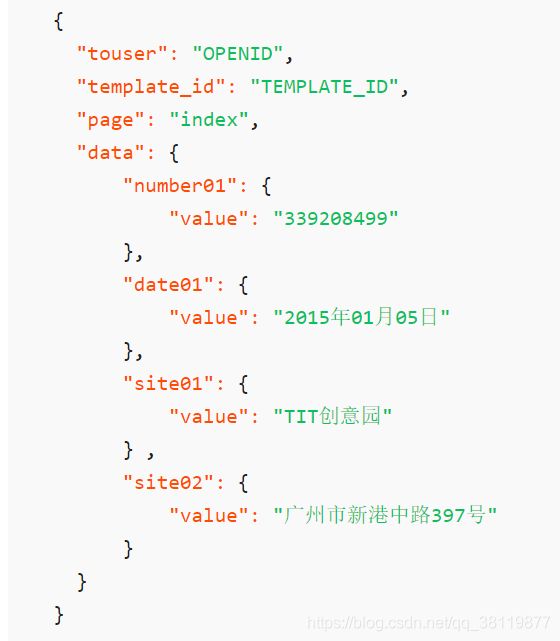微信小程序之消息订阅的实现
首先创建小程序的时候写上自己的小程序的APPID,不要使用测试号。
一开始写的时候老是报错,出现错误提示
{"errcode":47001,"errmsg":"data format error hint:"},
应该就是传值错误。
而且模板消息马上要下线了,要使用订阅消息,和之前的模板消息还是有一点点区别,至少在前端不需要传值到后端,但是需要一个认证,需要用户授权。
下面正式开始。
根据微信开发文档的步骤一步一步操作
https://developers.weixin.qq.com/miniprogram/dev/framework/open-ability/subscribe-message.html
1.去微信公众平台,自己先添加一个消息模板,记下模板id
2.获取授权
小程序wxml文件代码
小程序的js文件
data: {
tmplIds: '模板ID',
},
getTmplID: function () {
console.log('已接收消息1')
wx.requestSubscribeMessage({
tmplIds: [this.data.tmplIds],
success(res) {
console.log(res)
if (res['模板ID'] === 'accept') {
console.log('用户同意了')
wx.showToast({
title: '订阅OK!',
duration: 1000,
})
wx.request({
method: 'GET',
url: '后端接口',
//不是josn格式
header: {
'content-type': 'application/json'
},
data: {
},
//调用接口成功
success: function (res) {
console.log(res);
},
});
}
},
fail(err) {
//失败
console.error(err);
reject()
}
})
},
当使用wx.requestSubscribeMessage请求过后,小程序返回的是这样的数据
3.下面就是看后端怎么发送请求数据了。
首先要明确你要发送哪些数据,把数据都凑齐了,按照格式发送过去,这是文档里要求格式
那么先获取openid,在小程序端使用wx.login获得code,传到后端,这些代码是我在工程里面摘的,具体细节不太完整。
private JSONObject getUserWXLoginInfo(String wxCode) {
String requestUrl = "https://api.weixin.qq.com/sns/jscode2session";
Map requestUrlParam = new HashMap();
requestUrlParam.put("appid", AppID); //开发者设置中的appId
requestUrlParam.put("secret", AppSecret); //开发者设置中的appSecret
requestUrlParam.put("js_code", wxCode); //小程序调用wx.login返回的code
requestUrlParam.put("grant_type", "authorization_code"); //默认参数
//发送post请求读取调用微信 https://api.weixin.qq.com/sns/jscode2session 接口获取openid用户唯一标识
JSONObject jsonObject = JSON.parseObject(UrlUtil.sendPost(requestUrl, requestUrlParam));
return jsonObject;
}
@GetMapping("getopenid")
public String login(@RequestParam("code") String wxCode){
//请求微信api获取用户的openid和sessionKey
JSONObject jsonObject = getUserWXLoginInfo(wxCode);
if(jsonObject!=null&&!jsonObject.containsKey("openid")) {
return R.error().put("no_power","未授权!");
}
openid = (String)jsonObject.get("openid");
return openid
} 然后获取access_token和发送数据
//获取订阅消息推送的token
private JSONObject getUserWXOAthToken( ) {
String requestUrl = "https://api.weixin.qq.com/cgi-bin/token";
Map requestUrlParam = new HashMap();
requestUrlParam.put("appid", AppID); //开发者设置中的appId
requestUrlParam.put("secret", AppSecret); //开发者设置中的appSecret
requestUrlParam.put("grant_type", "client_credential"); //默认参数
//获取小程序全局唯一后台接口调用凭据(access_token)。调用绝大多数后台接口时都需使用 access_token,开发者需要进行妥善保存。
JSONObject jsonObject = JSON.parseObject(UrlUtil.sendPost(requestUrl, requestUrlParam));
return jsonObject;
}
@GetMapping("GetDYMsg")
public R msg() {
JSONObject jsonObject = getUserWXOAthToken();
String access_token = (String) jsonObject.get("access_token");
System.out.println(jsonObject);
String requestUrl = "https://api.weixin.qq.com/cgi-bin/message/subscribe/send?access_token="+access_token;
Map ParamList = new HashMap();
Map thing1=new HashMap();
Map thing8=new HashMap();
Map thing10=new HashMap();
thing1.put("value","shuju");
thing8.put("value","学习");
thing10.put("value","shuju");
ParamList.put("thing1",thing1);
ParamList.put("thing8",thing8);
ParamList.put("thing10",thing10);
Map requestUrlParam = new HashMap();
requestUrlParam.put("touser", openid); //开发者openid
requestUrlParam.put("template_id", "模板id"); //模板id
requestUrlParam.put("data", ParamList);
JSONObject jsonParamList=new JSONObject(requestUrlParam);
JSONObject jsonObject1 = JSON.parseObject(UrlUtil.sendPost(requestUrl, jsonParamList));
System.out.println(jsonObject1);
return R.ok(jsonObject1);
} 重点是,附上我的工具类UrlUtil.class,当时真的大部分时间都在这个httpclient的工具类上了。
package io.renren.modules.app.utils;
import java.io.BufferedReader;
import java.io.IOException;
import java.io.InputStreamReader;
import java.io.PrintWriter;
import java.net.URL;
import java.net.URLConnection;
import java.util.Iterator;
import java.util.Map;
import com.alibaba.fastjson.JSON;
import org.apache.log4j.LogManager;
import org.apache.log4j.Logger;
public class UrlUtil {
private final Logger LOG = LogManager.getLogger(this.getClass());
/**
* 向指定 URL 发送POST方法的请求
*
* @param url 发送请求的 URL
* @param paramMap 请求参数
* @return 所代表远程资源的响应结果
*/
public static String sendPost(String url, Map paramMap) {
PrintWriter out = null;
BufferedReader in = null;
String result = "";
String param = "";
Iterator it = paramMap.keySet().iterator();
while (it.hasNext()) {
String key = it.next();
param += key + "=" + paramMap.get(key) + "&";
}
try {
URL realUrl = new URL(url);
// 打开和URL之间的连接
URLConnection conn = realUrl.openConnection();
// 设置通用的请求属性
conn.setRequestProperty("accept", "*/*");
conn.setRequestProperty("connection", "Keep-Alive");
conn.setRequestProperty("Accept-Charset", "utf-8");
conn.setRequestProperty("user-agent", "Mozilla/4.0 (compatible; MSIE 6.0; Windows NT 5.1;SV1)");
// 发送POST请求必须设置如下两行
conn.setDoOutput(true);
conn.setDoInput(true);
// 获取URLConnection对象对应的输出流
out = new PrintWriter(conn.getOutputStream());
// 发送请求参数
out.print(param);
// flush输出流的缓冲
out.flush();
// 定义BufferedReader输入流来读取URL的响应
in = new BufferedReader(new InputStreamReader(conn.getInputStream(), "UTF-8"));
String line;
while ((line = in.readLine()) != null) {
result += line;
}
} catch (Exception e) {
e.printStackTrace();
}
//使用finally块来关闭输出流、输入流
finally {
try {
if (out != null) {
out.close();
}
if (in != null) {
in.close();
}
} catch (IOException ex) {
ex.printStackTrace();
}
}
return result;
}
/**
* 向指定 URL 发送POST方法的请求
*
* @param url 发送请求的 URL
* @param param 请求参数
* @return 所代表远程资源的响应结果
*/
public static String sendPost(String url, JSON param) {
PrintWriter out = null;
BufferedReader in = null;
String result = "";
try {
URL realUrl = new URL(url);
// 打开和URL之间的连接
URLConnection conn = realUrl.openConnection();
// 设置通用的请求属性
conn.setRequestProperty("accept", "*/*");
conn.setRequestProperty("connection", "Keep-Alive");
conn.setRequestProperty("Accept-Charset", "utf-8");
conn.setRequestProperty("user-agent", "Mozilla/4.0 (compatible; MSIE 6.0; Windows NT 5.1;SV1)");
// 发送POST请求必须设置如下两行
conn.setDoOutput(true);
conn.setDoInput(true);
// 获取URLConnection对象对应的输出流
out = new PrintWriter(conn.getOutputStream());
// 发送请求参数
out.print(param);
// flush输出流的缓冲
out.flush();
// 定义BufferedReader输入流来读取URL的响应
in = new BufferedReader(new InputStreamReader(conn.getInputStream(), "UTF-8"));
String line;
while ((line = in.readLine()) != null) {
result += line;
}
} catch (Exception e) {
e.printStackTrace();
}
//使用finally块来关闭输出流、输入流
finally {
try {
if (out != null) {
out.close();
}
if (in != null) {
in.close();
}
} catch (IOException ex) {
ex.printStackTrace();
}
}
return result;
}
}
至此,就结束了。记下自己学习的过程。




